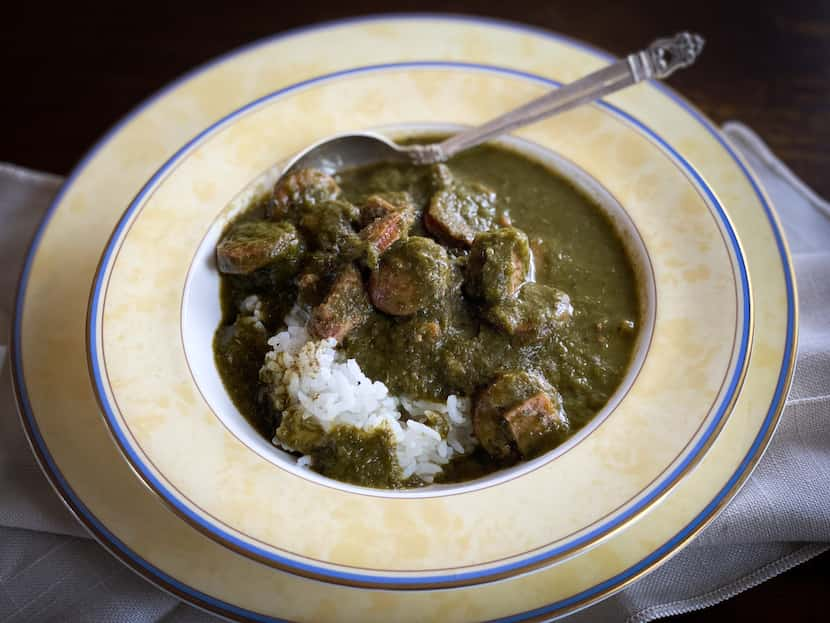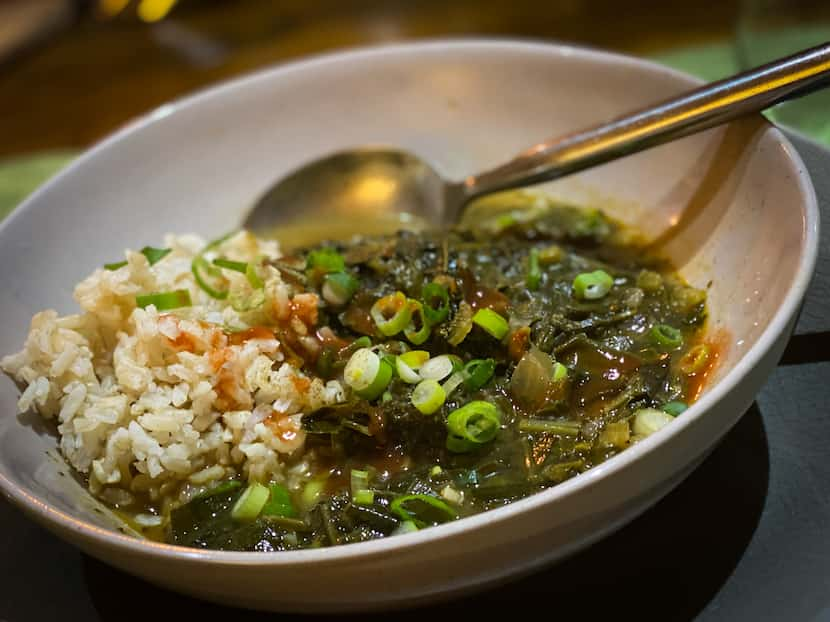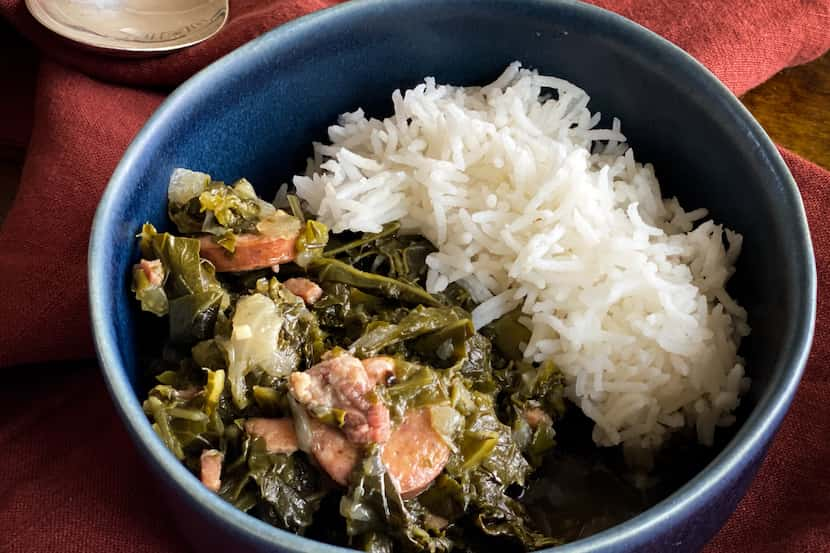Once a year, the Thursday before Easter (known by Catholics as Holy Thursday), New Orleanians gather at one of the city’s legendary restaurants to eat one of the most meaningful dishes in Louisiana Creole culture: gumbo z’herbes.
Dooky Chase’s Restaurant — the beloved Tremé institution that began life as Emily and Edgar “Dooky” Chase, Sr.’s sandwich shop in 1941 — has been serving the dish on Holy Thursday for decades. The holiday this year falls on April 6, and the restaurant is planning for its usual crowd; hopeful diners can call to add their name to a waiting list.
Its rendition of the soupy stew, called gumbo des herbes and regarded by many as the ultimate version, was created by the late, great chef Leah Chase, known as the “queen of Creole cuisine.” She and her husband, Edgar “Dooky” Chase, Jr., turned the New Orleans sandwich shop into a celebrated fine-dining restaurant that also became a center for the city’s arts community, as well as a meeting place for civil rights leaders in the 1960s. Today, Leah Chase’s signature red chef’s jacket hangs in the Smithsonian, and she was honored with the James Beard Foundation’s Lifetime Achievement Award in 2016.

The dish also has a fascinating story. The name gumbo z’herbes (pronounced gumbo zairbz) is a Creole contraction of the French gumbo aux herbes, so called because it contains multitudinous greens. It comes out of a Southern Louisiana tradition of cooking and eating green gumbo during Lent, the 40 days leading up to Holy Thursday. During that period, many observant Catholics abstain from eating meat on Fridays, and many gumbo z’herbes are vegan. Dooky Chase’s is not; it’s chock full of a whole lot of greens (usually nine, including mustard greens, collards, turnip greens, carrot tops, beet greens, spinach, cabbage, lettuce and watercress), as well as a whole lot of meat — two kinds of sausages, smoked ham, beef brisket and veal brisket.
It also includes filé (powdered sassafras), a traditional Choctaw ingredient, rather than okra, which is only in season in Louisiana and Texas from June through the first frost. Interestingly, etymologists disagree about whether gumbo gets its name from kombo (the Choctaw word for filé) or gombo (the word for okra in several West African languages).
If you’re now thoroughly confused because you thought gumbo always included seafood, chicken, sausage or other meats, you’re not alone. Just know that there as many kinds of gumbos as there are cooks in Louisiana.
Many gumbos begin with a roux — flour slowly cooked in butter, oil or other fat till it’s anywhere from golden to deep brown. And most include the “holy trinity” of Louisiana cooking: diced onion, celery and green bell pepper.

The recipe for Gumbo Des Herbes in Leah Chase’s The Dooky Chase Cookbook, first published in 1990, includes an ingredient not easily found outside of Louisiana — hot chaurice, a type of crumbly sausage. Two years ago, when I featured a story about gumbo z’herbes on my cooking website, Cooks Without Borders, I interviewed Dooky Chase’s current chef, Edgar “Dooky” Chase IV. He generously gave us permission to share the recipe from the book, and helped me find a substitute for the chaurice — Italian sausage plus extra cayenne — for our adaptation.
I loved cooking and adapting Dooky Chase’s iconic recipe, which does not begin with a roux but rather by chopping, boiling, then puréeing a giant mountain of those nine greens, plus onion and garlic (rather than holy trinity), then steaming all the meats except the crumbly sausage in the resulting pot liquor. (The crumbly sausage is cooked separately.) You then make a light roux, put everything together, and simmer about an hour. Finish the gumbo with filé powder, and serve over rice. Find the adaptation here.
Another wonderful version is the one Toni Tipton-Martin included in her award-winning 2019 book Jubilee: Recipes from Two Centuries of African American Cooking. An adaptation is included below. And here is a terrific recipe for vegan gumbo z’herbes created by Chloé Landrieu-Murphy, who wrote Cooks Without Borders’ deep dive into gumbo z’herbes.

Don’t feel like washing, trimming and chopping a giant mountain of greens? You can head to Restaurant Beatrice in Oak Cliff — one of only a couple of restaurants outside of Louisiana I’ve found that’s serving the dish this season. (The other is The Gumbo Bros. in Nashville, Tenn.)
At Beatrice, executive chef-owner Michelle Carpenter and executive chef Terance Jenkins are featuring two renditions on their current menu: Leah Chase’s Gumbo Z’Herbes and Vegan Green Gumbo.
“Gumbo Z’Herbes has a history and significance much greater than Restaurant Beatrice,” says Carpenter. “We are only 10 months old. The history of enslaved folks in Louisiana spans 300 centuries.”
She and Jenkins are featuring green gumbo because, she says, “We wanted to pay tribute and honor the faces who have shaped this dish, and we wanted to insert ourselves into the canon and legacy of Cajun and Creole foods. ... This dish is about the history of Louisiana, and our vegan interpretation is one way for us to look at our shared future.”
Former Dallas Morning News restaurant critic Leslie Brenner, now a restaurant consultant with Leslie Brenner Concepts, writes about cooking at Cooks Without Borders.
‘JUBILEE’ GUMBO Z’HERBES
1 1/2 pound collard greens, washed, stemmed and coarsely chopped
2 1/2 pounds greens (such as mustard, turnip greens, watercress, kale, chard, beet and carrot tops, spinach), washed, stemmed and coarsely chopped
1/4 head cabbage, coarsely chopped
1 tablespoon plus 1 3/4 teaspoons salt, plus more to taste
1/2 pound beef brisket, cut into 1/4-inch dice
3/4 teaspoon freshly ground black pepper, plus more to taste
2 tablespoons bacon drippings or vegetable oil
1/2 pound smoked andouille sausage, sliced into thick coins
1/2 pound ham, cut into 1/4-inch dice
2 cups chopped onions
1/2 cup sliced scallions
1 cup chopped green bell pepper
1 1/2 cups chopped celery
1 tablespoon minced jalapeño or serrano chile
1 tablespoon minced garlic (2 to 3 cloves)
1 teaspoon dried thyme
1/4 teaspoon cayenne pepper
2 bay leaves
1 quart chicken broth
2 tablespoons chopped parsley
1 tablespoon fresh thyme leaves
Cooked rice, for serving
In a very large Dutch oven or heavy soup pot, combine the collards and 6 1/2 cups water. Bring to a boil, then reduce the heat to medium and simmer until the collards are tender, about 30 minutes. Add the greens, cabbage and 1 tablespoon salt to the pot. Return to a boil, then reduce the heat to a gentle simmer and cook, covered, until the greens are very tender. (Depending on the greens you use, this could be more than an hour.) Making sure to reserve the cooking liquid (the “potlikker”), drain the greens in a colander, then coarsely chop them.
Measure the potlikker — you’ll need two cups. (If you have extra, reserve it for another use.) If you don’t have enough, add water to yield two cups. Set aside.
Season the brisket with 1/2 teaspoon of the salt and 1/4 teaspoon of the black pepper. In a large skillet, heat the bacon fat or vegetable oil over medium-high heat. Add the brisket, andouille sausage and ham and cook for 10 minutes, stirring occasionally, to render the fat and brown the meats. Stir in the onions, scallions, bell pepper, celery, jalapeño or serrano and garlic and sauté until the vegetables are tender-crisp, 3 to 5 minutes. Stir in the dried thyme, 1 1/4 teaspoon of the salt, 1/2 teaspoon of the black pepper and the cayenne, and cook until fragrant, 2 to 3 minutes longer.
In the Dutch oven or soup pot, combine the cooked greens, the reserved 2 cups of potlikker and the browned meat and vegetables. Cook for 15 minutes to concentrate the flavors. Stir in the bay leaves and chicken broth. Bring to a boil, then reduce the heat to medium-low, and cook until the meats are tender, about 45 minutes. Remove and discard the bay leaves, taste and adjust the seasoning. Stir in the parsley and fresh thyme. Serve over hot cooked rice.
Serves 10 to 12.
Source: “Jubilee: Recipes from Two Centuries of African American Cooking” by Toni Tipton-Martin

/cloudfront-us-east-1.images.arcpublishing.com/dmn/TXPHRVCZHJG7BPWBFMUWDNQFR4.jpg)
/cloudfront-us-east-1.images.arcpublishing.com/dmn/AZRLRQLVJBF7BEFEL3BWXA6CY4.jpg)
/cloudfront-us-east-1.images.arcpublishing.com/dmn/2TWCKJ3WRFDYPM6RWREXCDFVYQ.jpg)
/cloudfront-us-east-1.images.arcpublishing.com/dmn/EVCINWEHPBFIJNCERDMTZTYVIU.jpg)
/cloudfront-us-east-1.images.arcpublishing.com/dmn/VHEYQUNEY5HCPPMN55RDBFCNAQ.jpg)